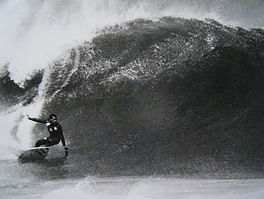
The History of Surfing...





Maids on the Wave by Wallace Mackay 1874

The traditional solid wood boards of Hawaii

Surfers of the 1940s

Surfers of the 1960s


The emergence of comps and contests in the 1970s & 1980s
Soul surfers today
Surfing is an ancient sport and, like all things that that have been in existence since time immemorial, its exact point of emergence is unknown. What is known is that nearly all ancient cultures who had access to waves developed some form of sport similar to surfing. Most histories of surfing illustrate Hawaii as the home of surfing, where it is believed to have emerged 1500 years ago. However, it is also believed that ancient Peruvians were surfing some 3000 years ago. Captain Cook was the first non-indigenous person to witness the art of surfing, documenting the sport in his expeditions to the Polynesian Islands during the 1700s.
Cook however, was also the man who indirectly brought about the demise of the sport. After Cook settled Hawaii, trade began to redefine the natural and indigenous lifestyle of the islands. Over these years, the practice of surfing diminished and by the 19th century, there were only a few natives that were still surfing. The decline of the sport has been directly linked to the decline of Indigenous peoples. Incidentally, it was also the Indigenous of Hawaii who brought about the revival of surfing. Duke Kahanamoko, otherwise known as the “Father of Modern Surfing”, created a surf club on Wakiki Beach. As an Olympic swimmer, Duke’s popularity brought much attention to the sport, especially in California. Up until this time there was a myth that only indigenous Hawaiians could sustain balance on a wave. However, this was soon discredited as both Indigenous and Caucasians hit the beaches of Hawaii.
Surfing was greatly influenced by the invention of the automobile. The car, once the Chevy and then later the VW campervan, enabled surfers to go up and down coastlines searching for that perfect wave and, in so doing, the concept of the “surf safari” emerged. The 1950s has been termed the proverbial “Golden Ages” of surfing. It was during this post war period that leisure time prospered. With the help of fashion labels and TV shows, surfing soon became commercialised. It was from this point forward that a divide emerged between professional surfers and soul surfers.
The term ‘soul surfer’ emerged during the 1960s. Unlike a pro surfer, a soul surfer is concerned with the spirituality of surfing. Jim White, a musician and ex-pro surfer, once said:
Life is our struggle between the desire for separation and our desire for union. But to ride a wave you have to completely forget yourself; you have to be absorbed in the moment, or you’ll fall off. So every wave is about union, it’s a momentary connection with something far beyond yourself, and that doesn’t happen very often. Surfing may be the easiest way to access this union; surfing is like a heroin injection of union.
Soul surfing is about engaging with nature, about surfing for leisure and enjoyment . Soul surfing has been described as equivalent to Nirvana, Satori, and Total Enlightenment. It is the unity of man with nature that encourages this feeling of harmony.
Thomas Mitchell describes a soul surfer as an one who “borrows the wave’s spirit for a short while and uses his body and equipment to translate the essence of the wave’s spirit into art”. While many might interpret this statement as grandiose, the soul surfer will understand its basic meaning: the pure satisfaction of partaking in the natural phenomenon of the ocean.
Few non-surfers will ever witness the beauty of a soul surfer as these are people who do no promote themselves. Soul surfers typically do not partake in surfing contests or competitions, they are often not sponsored and do not surf for anyone else but themselves. In this way, many do not notice that soul surfers attain the highest level of surfing success and are often highly skilled sportsmen, for they partake in an art beyond evaluation, incapable of judgement.
Those who do attain sponsors and recognition are often considered to be reformed, and thus not soul surfers at all. And, importantly, a soul surfer will use any form of surfing equipment, from traditional long boards to modern short boards.
Soul surfing is not a sport or a hobby; it is a lifestyle.

